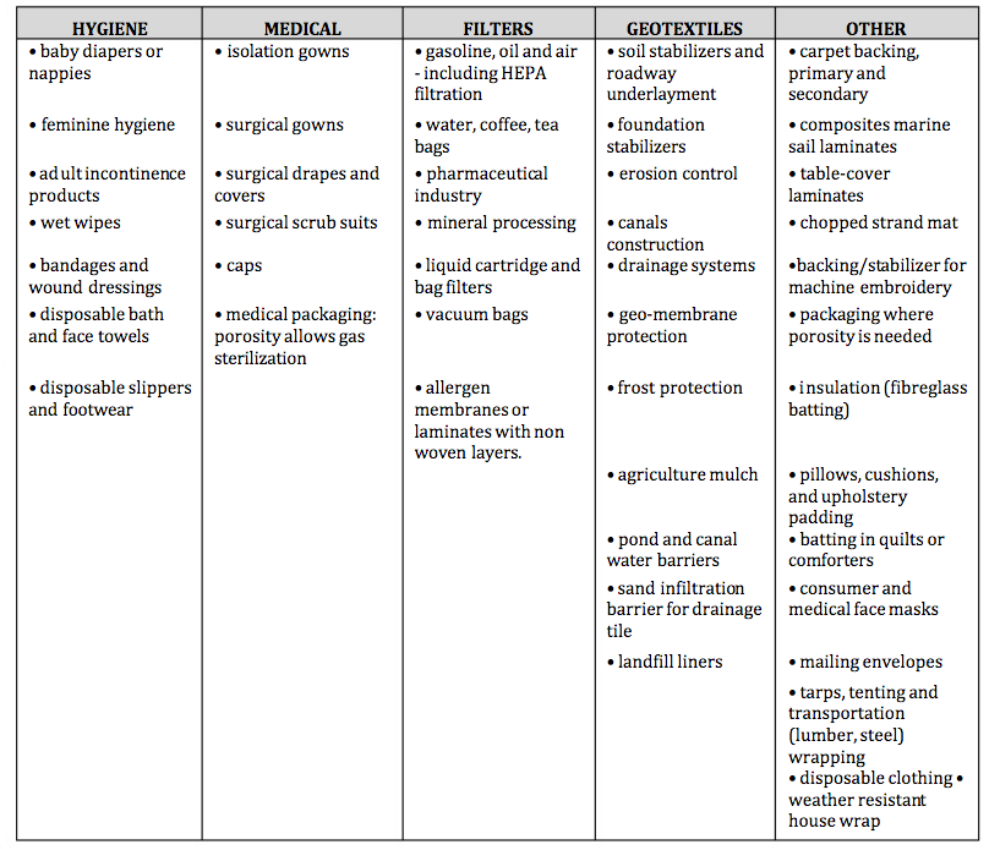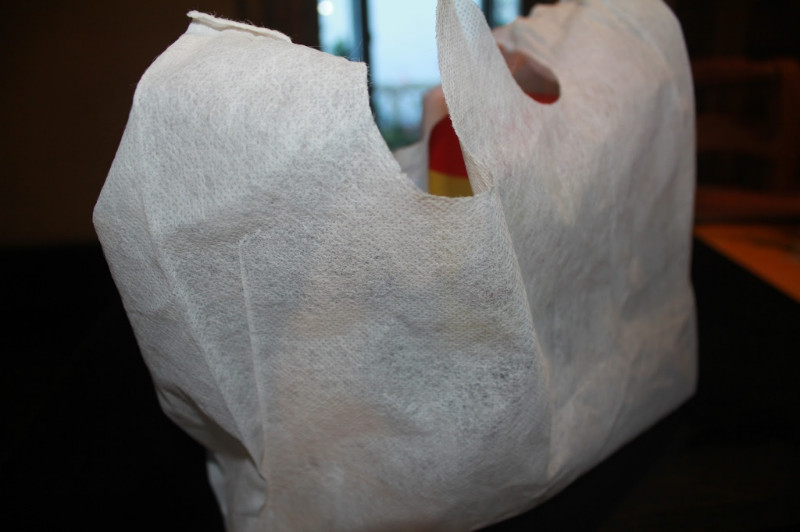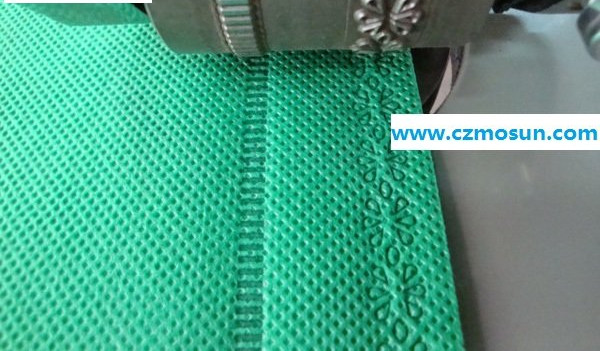Non woven fabrics are spun bond polypropylene...which means...they are PLASTIC!
In the aftermath of the recent ban on plastic disposable bags, the markets are seeing a marked increase of non woven carry bags being handed out by retail stores. This material which has a texture embossed on it , often feels like cloth and so many people mistake it for cloth.
What is Non Woven material? Here is a detailed look into it...
1. Manufacturing process
2. Applications
3. Carry bags
4.Disposal
5. Recycling
6. Regulations
7. Comparison of cloth and non woven bags
|
|
|
Photos source: Left : http://m.spunlacenonwovenfabric.com Right : www.nonwovenexperts.com
|
|
|
Nonwoven fabrics are engineered fabrics that may be single-use, have a limited life, or be very durable. Nonwoven fabrics provide specific functions such as absorbency, liquid repellence, resilience, stretch, softness, strength, flame retardancy, washability, cushioning, thermal insulation, acoustic insulation, filtration, use as a bacterial barrier and sterility. These properties are often combined to create fabrics suited for specific jobs, while achieving a good balance between product use-life and cost. They can mimic the appearance, texture and strength of a woven fabric and can be as bulky as the thickest paddings. In combination with other materials they provide a spectrum of products with diverse properties, and are used alone or as components of apparel, home furnishings, health care, engineering, industrial and consumer goods. ( Source: Wikipedia)
In India, non woven materials are usually seen in either of two textures - a dotted grid like pattern or a zig zag texture of fibres. The former is normally available in a slightly thicker sheet and the latter in a thinner density. Both of them are - NOT WOVEN - they are either extruded or thermally bonded . Made using plastic chips or filaments the process of manufacture involves melting the chips and extruding it into sheets which are then embossed with a pattern. Fibres that are thermally bonded without weaving them also result in non woven materials. |
|
Photos source: Left : http://www.atextechnologies.com
Right : www.nonwovenexperts.com
|
|
|
|
Photos source: www.unitika.co.jp
|
|
|
|
The final product gets wound up in a roll that is then given down further to the supply chain to those who transform it into other consumable products.
China is one of the largest manufacturers of non woven materials. China produced over 5 million tons of non woven bags in 2016 and its production rate is increasing every year.
|
|
From carry bags to tea bags to disposable caps, masks, gowns and shoe covers used in hospitals; this material has now found usage in our day to day life. Aprons, scouring pads, diapers, sanitary napkins, table cloths and mats, book covers, envelopes are to name a few. So just like plastic, the application of non woven is as varied and wide. In most cases it is being used for single use disposable items. |
|
Photos source: Teabags: pngtree.com Cap: disosablecoverallsuit.com
Apron: glowroad.com Bags: Deekshabags.com
|
|
|

|
|
Source:Recycling of Non Woven Waste ,Usha Sayed, Sneha Parte , Department of Fibres and Textile Processing Technology, Institute of Chemical Technology
|
|

|
|
Source: www.darjeelingprerna.com
|
|
The blanket ban on plastic bags in Maharashtra imposed by the government has given rise to a booming market of all kinds of carry bag alternatives for people. The primary option that is flooding the markets everywhere in the city are the non woven bags which are the cheapest available alternative. Manufacturers are trying to mislead the public into believing that this material is cloth and hence environmentally safe and viable. Many are unaware of the fact that these bags are very much covered by the ban in the state as non woven bags are in fact polypropylene which is a thermoplastic polymer. But contrarily there is a common belief that these non woven bags are in fact environmentally safe and largely recyclable.
Non woven carry bags do not require to be stitched as the material is sensitive to heat and can be thermally bonded. Hence it is noticeable that the joints and seams of non woven carry bags are made through sealing and not sewing. This reduces the cost of making the bags tremendously as they can be very quickly sealed together industrially as opposed to cloth bags that need to be sewn.

|
|
|
DISPOSAL OF NON WOVEN MATERIALS
|
|
|
Non woven materials are NOT biodegradable. They will not degrade if just thrown into the landscape or if they end up in landfill.The raw materials of plastic bags are polyethylene and that of non woven bags is polypropylene. Polypropylene and polyethylene are both forms of plastic that do not disintegrate in nature.
When heated, polypropylene liquefies and releases harmful toxic chemicals. Many claim that since it has the property to liquefy at high temperature, it is easily recyclable as compared to polythene. But in reality, it is not economically viable to recycle polypropylene.
Another aspect of disposal is 'flushability'. Since many of the uses of non woven materials are in medical disposable products such as sanitary pads, they are end up being flushed down toilets. This leads to mechanical issues as well as further pollutes waste water.
Currently, the industry is also realising that different plastic materials release micro particles of plastic into the environment. These micro plastics are so tiny in size that they are nearly invisible to the naked eye. When they enter marine ecosystems it is impossible to clean them out and they enter food chains. Fishes are now found to contains micro plastics to high levels. |
|
|
CAN NON WOVEN MATERIALS BE RECYCLED?
|
|
|
|
While the industry claims that non woven materials lend themselves to recycling, the cost effectiveness of collecting non woven materials from waste and then recycling them is unrealistic. Also since most of the applications of non woven in disposable consumables require it to be used in a very thin density, the amount of material that can be recovered in a recycling process is minimal and therefore does not justify the costs of recycling.
Effectively, disposable non woven products simply add to the plastic waste that reaches landfill.
|
|
|
REGULATIONS AROUND NON WOVEN BAGS
|
|
|
It is only recently that the government has started to recognise and acknoweldge that non woven carry bags are as harmful as ordinary plastic bags. The recent ban on plastic disposables in Maharashtra, includes and specifically mentions non woven materials as well.
However as the awareness levels around non woven materials is very low, implementation of this ban is a challenge. Retail store owners are also confused about the material and are freely giving out non woven bags with the idea that it is cloth.
When the ban was first announced, officials of the Pune Municipal Corporation were instructed to carry samples of non woven bags to show retailers that these were also included in the ban on plastic bags. However a lot more needs to be done in this regard starting with a regulation on the import and manufacture of non woven carry bags. |
|
|
|